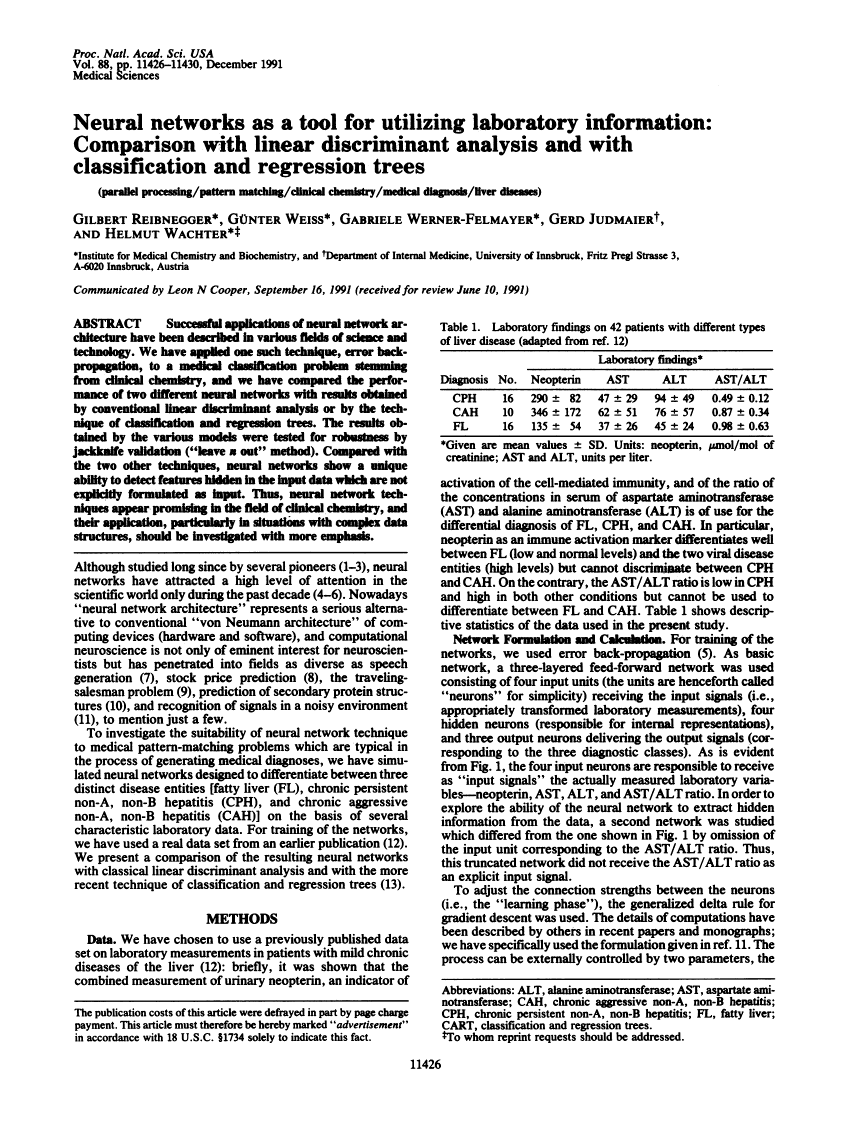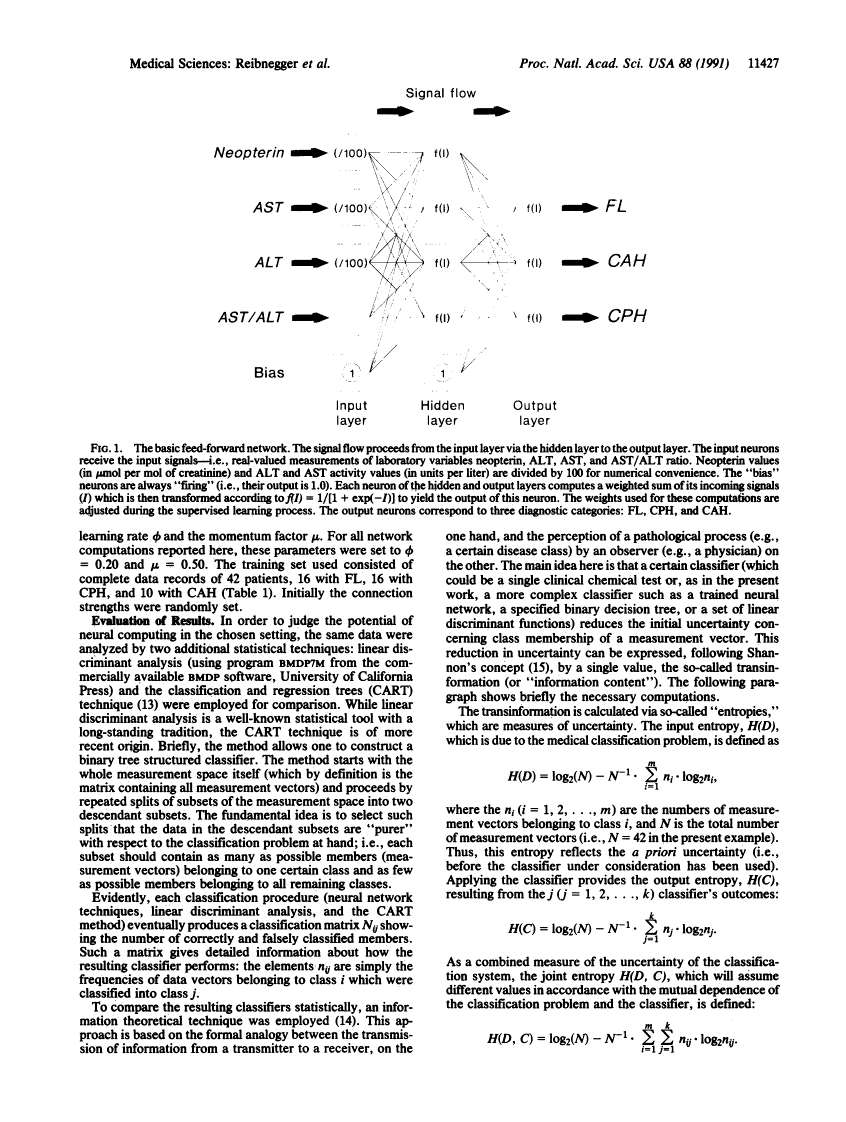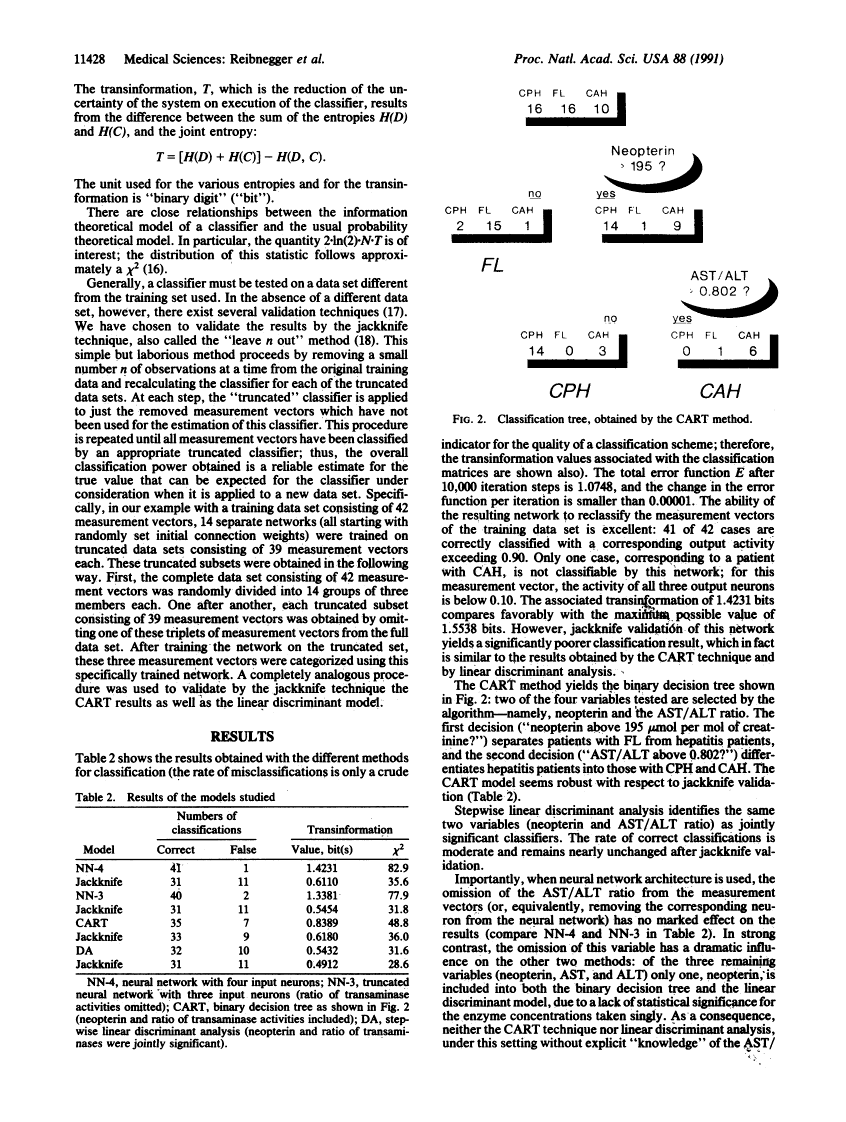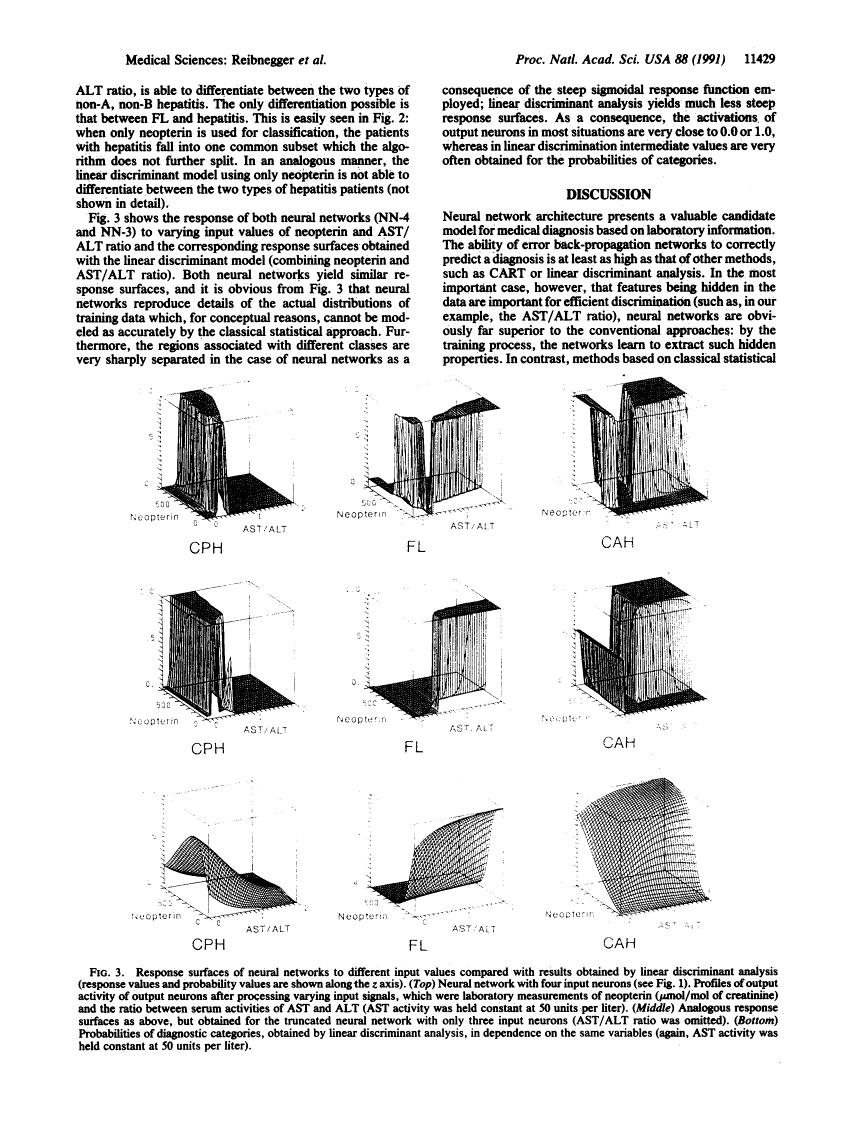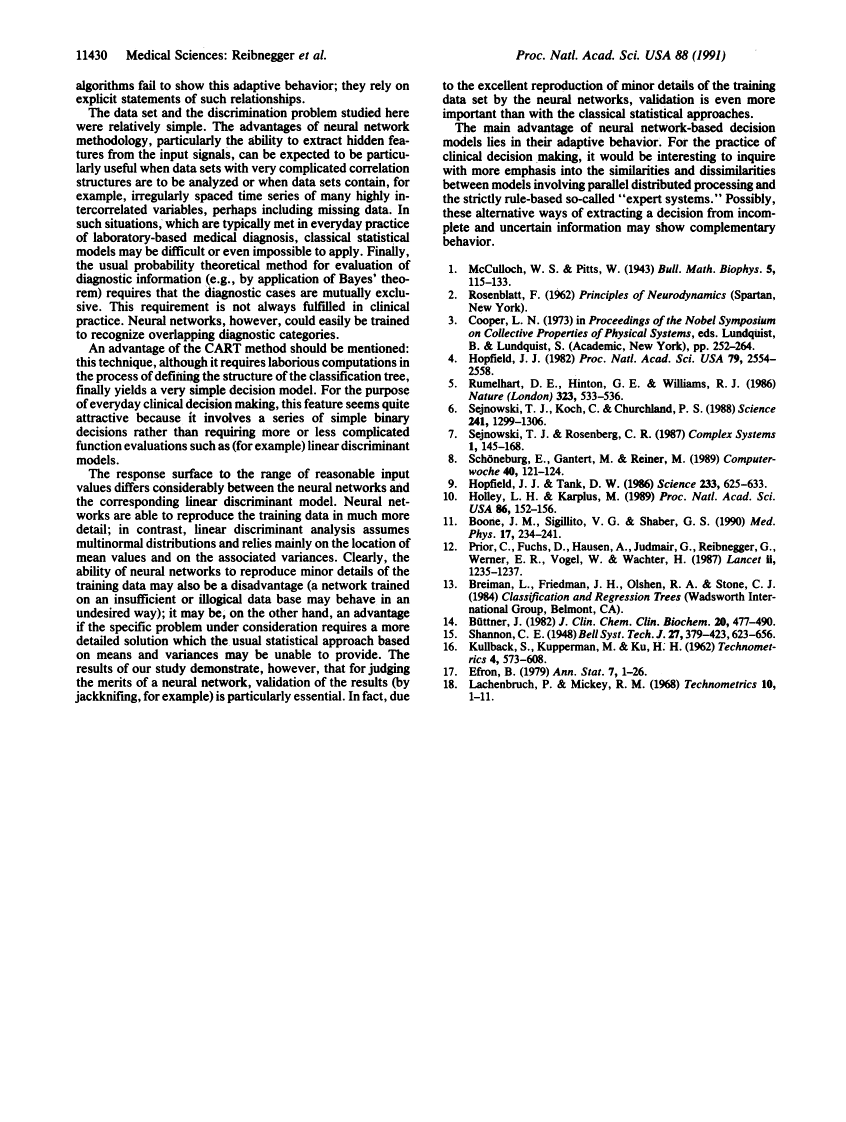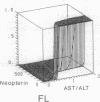Abstract
Free full text

Neural networks as a tool for utilizing laboratory information: comparison with linear discriminant analysis and with classification and regression trees.
Abstract
Successful applications of neural network architecture have been described in various fields of science and technology. We have applied one such technique, error back-propagation, to a medical classification problem stemming from clinical chemistry, and we have compared the performance of two different neural networks with results obtained by conventional linear discriminant analysis or by the technique of classification and regression trees. The results obtained by the various models were tested for robustness by jackknife validation ("leave n out" method). Compared with the two other techniques, neural networks show a unique ability to detect features hidden in the input data which are not explicitly formulated as input. Thus, neural network techniques appear promising in the field of clinical chemistry, and their application, particularly in situations with complex data structures, should be investigated with more emphasis.
Full text
Full text is available as a scanned copy of the original print version. Get a printable copy (PDF file) of the complete article (1.4M), or click on a page image below to browse page by page. Links to PubMed are also available for Selected References.
Images in this article
Selected References
These references are in PubMed. This may not be the complete list of references from this article.
- Hopfield JJ. Neural networks and physical systems with emergent collective computational abilities. Proc Natl Acad Sci U S A. 1982 Apr;79(8):2554–2558. [Europe PMC free article] [Abstract] [Google Scholar]
- Brain SD, Tippins JR, Morris HR, MacIntyre I, Williams TJ. Potent vasodilator activity of calcitonin gene-related peptide in human skin. J Invest Dermatol. 1986 Oct;87(4):533–536. [Abstract] [Google Scholar]
- Sejnowski TJ, Koch C, Churchland PS. Computational neuroscience. Science. 1988 Sep 9;241(4871):1299–1306. [Abstract] [Google Scholar]
- Hopfield JJ, Tank DW. Computing with neural circuits: a model. Science. 1986 Aug 8;233(4764):625–633. [Abstract] [Google Scholar]
- Holley LH, Karplus M. Protein secondary structure prediction with a neural network. Proc Natl Acad Sci U S A. 1989 Jan;86(1):152–156. [Europe PMC free article] [Abstract] [Google Scholar]
- Boone JM, Sigillito VG, Shaber GS. Neural networks in radiology: an introduction and evaluation in a signal detection task. Med Phys. 1990 Mar-Apr;17(2):234–241. [Abstract] [Google Scholar]
- Prior C, Fuchs D, Hausen A, Judmaier G, Reibnegger G, Werner ER, Vogel W, Wachter H. Potential of urinary neopterin excretion in differentiating chronic non-A, non-B hepatitis from fatty liver. Lancet. 1987 Nov 28;2(8570):1235–1237. [Abstract] [Google Scholar]
- Büttner J. Grundlagen der Anwendung der Informationstheorie auf qualitative klinisch-chemische Untersuchungen. J Clin Chem Clin Biochem. 1982 Jul;20(7):477–490. [Abstract] [Google Scholar]
Associated Data
Articles from Proceedings of the National Academy of Sciences of the United States of America are provided here courtesy of National Academy of Sciences
Full text links
Read article at publisher's site: https://doi.org/10.1073/pnas.88.24.11426
Read article for free, from open access legal sources, via Unpaywall:
https://europepmc.org/articles/pmc53148?pdf=render
Citations & impact
Impact metrics
Citations of article over time
Alternative metrics
Smart citations by scite.ai
Explore citation contexts and check if this article has been
supported or disputed.
https://scite.ai/reports/10.1073/pnas.88.24.11426
Article citations
Laboratory variables-based artificial neural network models for predicting fatty liver disease: A retrospective study.
Open Med (Wars), 19(1):20241031, 13 Sep 2024
Cited by: 0 articles | PMID: 39291279 | PMCID: PMC11406433
Comparison of Diagnosis Accuracy between a Backpropagation Artificial Neural Network Model and Linear Regression in Digestive Disease Patients: an Empirical Research.
Comput Math Methods Med, 2021:6662779, 27 Feb 2021
Cited by: 7 articles | PMID: 33727951 | PMCID: PMC7937476
Review Free full text in Europe PMC
First Principles Neural Network Potentials for Reactive Simulations of Large Molecular and Condensed Systems.
Angew Chem Int Ed Engl, 56(42):12828-12840, 18 Aug 2017
Cited by: 89 articles | PMID: 28520235
Review
Medical Dataset Classification: A Machine Learning Paradigm Integrating Particle Swarm Optimization with Extreme Learning Machine Classifier.
ScientificWorldJournal, 2015:418060, 30 Sep 2015
Cited by: 6 articles | PMID: 26491713 | PMCID: PMC4605351
Superolateral hoffa fat-pad edema and patellofemoral maltracking: predictive modeling.
AJR Am J Roentgenol, 203(2):W207-12, 01 Aug 2014
Cited by: 17 articles | PMID: 25055295
Go to all (34) article citations
Similar Articles
To arrive at the top five similar articles we use a word-weighted algorithm to compare words from the Title and Abstract of each citation.
Generalized likelihood ratio concept and logistic regression analysis for multiple diagnostic categories.
Clin Chem, 35(6):990-994, 01 Jun 1989
Cited by: 3 articles | PMID: 2499433
Potential of urinary neopterin excretion in differentiating chronic non-A, non-B hepatitis from fatty liver.
Lancet, 2(8570):1235-1237, 01 Nov 1987
Cited by: 18 articles | PMID: 2890855
Artificial neural networks in laboratory medicine and medical outcome prediction.
Clin Chem Lab Med, 37(9):845-853, 01 Sep 1999
Cited by: 21 articles | PMID: 10596951
Review
Differential diagnosis between non-A, non-B hepatitis and fatty liver by measurement of urinary neopterin.
Lancet, 1(8584):529, 01 Mar 1988
Cited by: 1 article | PMID: 2893936
